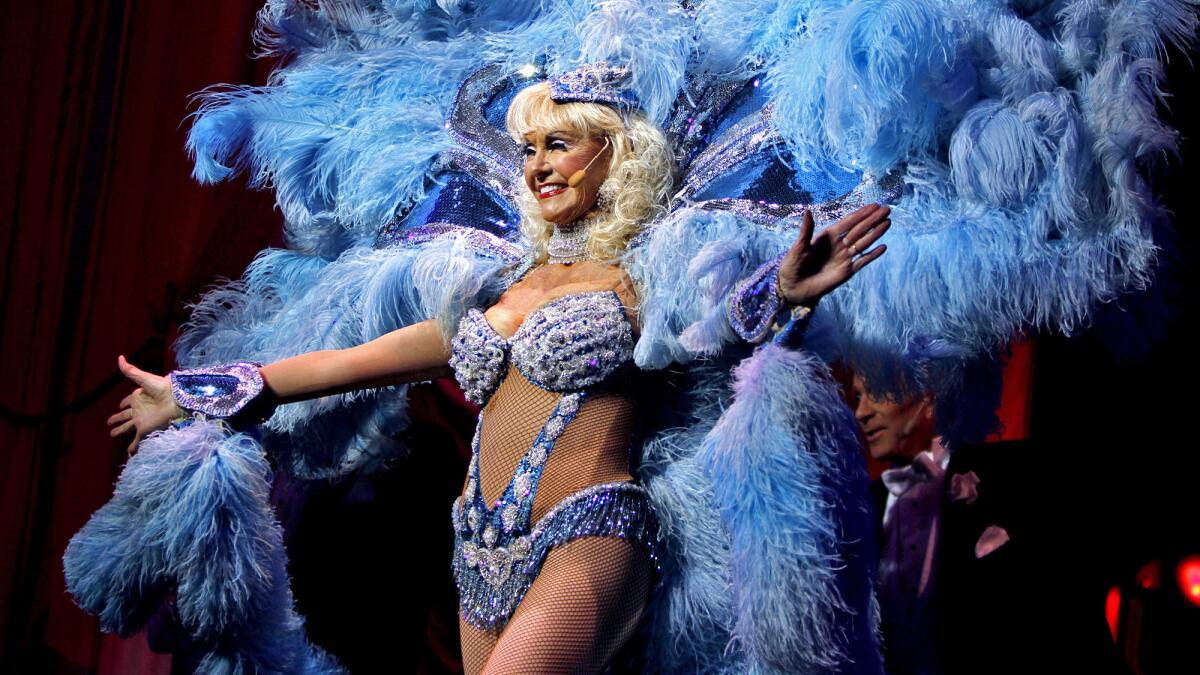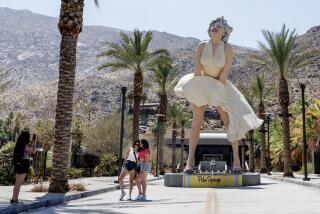Great Read: The Fabulous Palm Springs Follies nears last hurrah in prime form

Reporting from PALM SPRINGS — It was 10 minutes before showtime and Joni Naber was putting the final touches on her costume — a blue explosion of tassels and sequins that wasn’t doing a very good job of covering her body.
“Come here and feel this!” she called out, grabbing a reporter’s hand and placing it squarely on her midriff.
Her abdominals felt tight and smooth, like a piece of molded plastic.
“It’s a corset,” the 77-year-old former USO dancer explained with a grin.
In the cramped dressing room of the Plaza Theatre, 10 other showgirls were prepping for a matinee show. “Stop flirting with the reporter,” one called out.
Naber is a dancer in the Fabulous Palm Springs Follies, the musical revue and local institution that for the last 23 years has featured performers who could all claim AARP membership. The current cast ranges in age from 55 to 84.
Dancing in a corset isn’t the hardest part of the show, Naber said. The finale is a killer, requiring dancers to descend a staircase in 3-inch heels while singing the national anthem and carrying large American flags.
“Oh man, that’s so hard. Especially when you get to be 77,” she said.
Finales have been on everyone’s mind at the Follies. The Broadway-style revue will play its last show Sunday, bringing to an end a run that will have seen 4,849 performances, 4 million audience members and two Guinness World Records (for the world’s oldest chorus line and oldest showgirls, one of whom could still do splits at 87.)
Naber still can’t believe it: “I was ready to stay here and dance forever.”
::
Declining ticket sales and rising costs have made the Follies impossible to sustain, owners of the show say. In recent seasons, performers have played to half-filled houses.
They also pointed to wider cultural changes in Palm Springs, with events such as the Coachella music festival and the gay-themed White Party taking a more prominent place in the city’s public image during the last decade.
“We used to say that Palm Springs was old, gray and gay,” said Mary Jardin, a co-owner of the Follies. “It’s still gay, but there’s more emphasis on attracting young people to the city.”
But even as Palm Springs changed, the Follies never strayed from its central mission of spotlighting senior dancers.
“Living in the desert, we knew there were a lot of retired performers here,” Jardin said.
Over the years, the cast has included a former Rockette, veteran Broadway dancers, retired Vegas showgirls and nightclub entertainers.
The audiences have also been mostly elderly. The theater comes equipped with a defibrillator, and managers used to keep a supply of disposable underwear, in case of accidents.
Many of the show’s loyal fans have been dying over the years, said Riff Markowitz, the Follies’ wisecracking emcee and co-founder. He and Jardin used to be married but are now just business partners.
“We’ve lost so many people in the previous two years alone,” he said. “There’s a lack of consideration of some old people in that they insist on dying.”
Markowitz, a former TV producer, emcees each Follies performance with a routine that includes old-people jokes (prostates, flatulence) and humorously salty interactions with the audience (regarding the theater’s defibrillator, he has been known to say: “If you’re going to have a heart attack, have it here.”)
The 75-year-old host has never missed a show and has appeared onstage even when he was ill. The personal touch has helped the show attain a national reputation. A short documentary about the show titled “Still Kicking” was nominated for an Academy Award in 1998.
Producers said the company costs $6 million to run annually and that the show has been running in the red in the last couple of seasons.
But since the announcement of the closure, the Follies has seen business bounce back, with performances selling out again.
Over the years, the show has attracted a number of hard-core fans who have become something like groupies. “It’s difficult for someone who hasn’t seen the show to understand,” said Russell Higley, a resident of upstate New York who has seen the Follies hundreds of times in the last decade and has become an audience fixture.
“I’m 67 and at my age, you’re starting to feel sorry for yourself — the aches and pains,” he said. “You go to the Follies and you’re injected with this incredible energy. Watching them has given me hope. They inspire people.”
::
Back in the dressing room, the dancers were making sure that their wigs were on straight and their cleavage was looking perky.
Standing on the sidelines were the teams of dressers who help them in and out of the complex costumes during scene breaks.
The queen bee dancer is Leila Burgess, a 78-year-old former New Yorker who has been with the Follies for 22 years.
“I remember when I first started, it was just one set and a couple of lights. It just kept growing and I’ve never been bored,” said Burgess, who worked as a young dancer in New York’s Latin Quarter nightclub and eventually operated a dance school in Costa Mesa. (She is currently in a relationship with Markowitz.)
Like a number of the show’s performers, Burgess has overcome health problems to keep dancing. A knee injury sidelined her a couple of seasons ago, and a doctor recommended surgery. But Burgess, who had originally intended to skip the last season, opted for physical therapy and her injury eventually healed.
Dick France, who at 84 is the show’s oldest current performer, had been with the Follies for just a few years when he learned in 2004 that he needed heart surgery.
“I had had a heart attack and it was toward the end of the season,” the veteran Broadway dancer recalled. “I finished out the season. I went to Tucson and had a quadruple bypass.
“In 2005, I returned — no second thoughts. I wanted to go back. My folks were in vaudeville, so dancing and performing is all I know.”
::
After each show, the entire cast greets audience members as they file out of the theater.
“I like the idea that they come outside. It gives us a closeness to the people, and you get to find out more about them,” said Margie Price, a Westlake Village resident who has been to the Follies nearly 15 times.
Price was at the show with a group of volunteers from the Ronald Reagan Presidential Library in Simi Valley. A large portion of the Follies audience comes as part of groups or tour packages that have brought a reliable flow of tourist dollars to the Palm Springs economy.
“It’s going to be really hard for Palm Springs,” said Mindy Reed, owner of Alicante, a Spanish Mediterranean restaurant located near the Plaza Theatre. She said 35% to 45% of the restaurant’s lunch business comes from Follies patrons.
“The show has brought a phenomenal number of people to the city,” she said. “It will be horribly missed not just by the restaurants but also by a lot of merchants in downtown.”
The fate of the historic Plaza Theatre remains up in the air. Officials with the city and the Follies said others have expressed interest in taking over the 809-seat venue, including the Palm Springs International Film Festival.
But the theater will need at least $2 million in renovations because of its advanced age, said David Ready, Palm Springs’ city manager. The city hopes to partner with a future tenant to help shoulder the costs.
As for the cast and staff of Follies, some have decided to retire while others intend to keep on working, though not necessarily onstage. Naber, the former USO dancer, said she plans to work as a docent for the city’s historical society after the show ends.
“I will miss everything here,” she said. “It has given me a purpose. I mean, they hired me when I was 70 — that’s incredible, isn’t it?”
More to Read
Sign up for Essential California
The most important California stories and recommendations in your inbox every morning.
You may occasionally receive promotional content from the Los Angeles Times.











